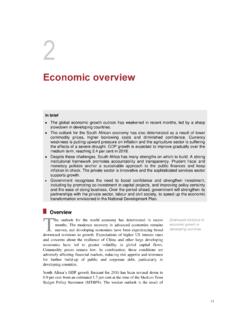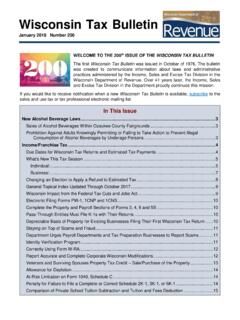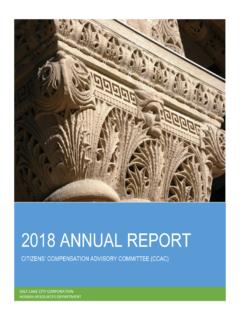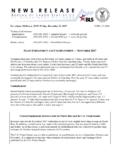Transcription of Government’s borrowing requirement and other obligations
1 7. government 's borrowing requirement and other obligations In brief government 's gross borrowing requirement is expected to be billion in 2016 /17, increasing to billion in 2019/20. Debt-service costs are estimated to be billion in 2016 /17, or per cent of GDP, increasing to billion, or per cent of GDP in 2019/20. Deep and liquid domestic capital markets will remain the main source of borrowing . Despite volatile market conditions, debt remains within strategic risk benchmarks. Eskom, independent power producers and the Road Accident Fund account for the majority of government 's contingent liabilities.
2 Overview G. overnment borrows money to finance the difference between revenue and expenditure, and to pay debt that is due. In 2016 /17, the budget deficit amounts to an estimated billion. Debt repayments amount to billion, bringing the total borrowing requirement to billion. government cannot always balance its budget through tax increases and government needs to spending cuts. It therefore needs to borrow at sustainable levels to fund borrow at sustainable levels expenditure. borrowing at reasonable cost depends on the lender's to fund its policy agenda perception of the borrower's ability to repay.
3 In bond markets, lenders consider the credibility of a government 's macroeconomic framework, the integrity of state institutions, the political environment and the country's economic growth prospects. These assessments are captured in sovereign credit ratings. In South Africa's case, rating agencies are concerned by low economic growth rates, political risk, policy uncertainty, and the weak balance sheets of state-owned companies. Global developments can translate into financial market risks, affecting borrowing costs. During 2016 , the UK's vote to leave the European Union 81. 2017 BUDGET REVIEW.
4 And policy uncertainty in the wake of the presidential election in the US. resulted in market volatility and increased risk, which negatively affected some bond and Treasury bill auctions. Financing strategy Issuance of Treasury bills to In 2017/18, the gross borrowing requirement will be billion. decline and long-term government also expects to borrow billion to increase its cash bonds to increase over reserves to meet future commitments. medium term The financing strategy focuses on mitigating risks presented by the increase in loan redemptions over the next several years. To manage maturing debt, the bond-switch programme, which exchanges bonds with shorter maturities for longer-dated bonds, will continue.
5 Issuance of Treasury bills will be reduced to manage refinancing risk associated with low demand at auctions, and to minimise the impact of adverse interest- rate movements. Treasury bill issuance will average billion per year. Gross domestic long-term bond issuance will grow from billion in 2016 /17 to an annual average of billion to meet the higher borrowing requirement . As a result, weekly bond auction amounts will increase. Foreign-currency borrowing will average US$2 billion per year. The increase in debt stock, the issuance of longer-dated bonds that attract higher interest payments, and the exchange of short- for longer-dated instruments, will put some upward pressure on debt-service costs.
6 The sources of government borrowing government has three main sources of borrowing : Short-term borrowing consists of Treasury bills issued with maturities of up to a year and borrowing from the Corporation for Public Deposits. These instruments are used to cover part of the borrowing requirement and short-term cash-flow needs. The Corporation for Public Deposits, administered by the Reserve Bank, is where provinces and state-owned companies invest their surplus cash. Domestic long-term borrowing consists of fixed-rate bonds, inflation-linked bonds and retail savings bonds. Long-term debt minimises refinancing risk the probability that government will not be able to pay loans as they come due by curbing short-term repayment pressures.
7 Foreign-currency borrowing is denominated mostly in US dollars and euros. government uses this type of borrowing partly to meet foreign-currency commitments. The main risks to government 's financing strategy are: Macroeconomic and fiscal risk. Persistently weak economic growth, a deterioration in the fiscal position and/or demands for additional guarantees or capital injections for state-owned companies would likely increase debt and borrowing costs. Financial market risk. Policy uncertainty and political noise ahead of the governing party's elective conference in December 2017 could add to market volatility.
8 Lack of clarity on the policy trajectory of the US administration may lead to capital flow volatility. Inflation and exchange rate risk. Rising inflation and persistent rand depreciation could increase the stock of outstanding inflation-linked and foreign-currency debt, resulting in higher debt-service costs. 82. CHAPTER 7: government 'S borrowing requirement AND other obligations . Ratings risk. A downgrade to sub-investment grade ratings would increase borrowing costs and narrow the range of institutions that can invest in South African government debt. government 's approaches to macroeconomic, fiscal and state-owned Strategic benchmarks in company risks are discussed in Chapters 2, 3 and 8 respectively.
9 To place to manage inflation, manage risks directly linked to the financing strategy (inflation, exchange exchange rate, interest rate rate, interest rate and refinancing), government applies a series of strategic and refinancing risk benchmarks, presented in Table below. All debt metrics are expected to remain within their ranges or limits over the medium term. Table Performance against strategic portfolio risk benchmarks Benchmark 2016 /17 2017/18 2018/19 2019/20. range or Description limit Estimate Medium-term estimates 1. Benchmark Treasury bills as % of domestic debt 15 Long-term debt maturing in 5 years as % of 25 fixed-rate bonds and inflation-linked bonds Inflation-linked bonds as % of domestic debt 20-25 Foreign debt as % of total debt 15 Weighted term-to-maturity of fixed-rate bonds 10-14 and Treasury bills (years).
10 Weighted term-to-maturity of inflation-linked 14-17 bonds (years). 2. other indicators (weighted average). Term-to-maturity of total debt (years) Term-to-maturity of foreign debt (years) 1. Excludes borrowing from the Corporation for Public Deposits, retail savings and zero-coupon bonds 2. Indicators without specific benchmarks Source: National Treasury government debt and debt-service costs Table summarises national government debt. Table Total national government debt1. End of period 2015/16 2016 /17 2017/18 2018/19 2019/20. R billion Outcome Estimate Medium-term estimates 2. Domestic loans 1 819 2 016 2 215 2 415 2 616.
















